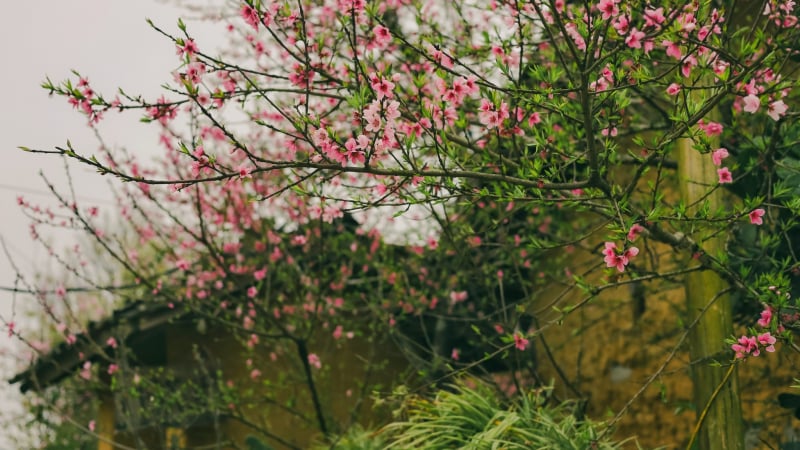Recently, in Huzhou, Zhejiang Province, China, Vietnamese tourism made history when the United Nations Tourism Organization (UN Tourism) announced the list of "Best Tourism Villages in the world 2025". Surpassing more than 270 profiles from 65 countries around the world, Lo Lo Chai Cultural Tourism Village (Lung Cu Commune, Tuyen Quang Province) and Quynh Son Community Tourism Village (Bac Son Commune, Lang Son Province) were recognized as two of the most outstanding community tourism villages in the world.

Lo Lo Chai village (Lung Cu commune) is located at the foot of Lung Cu flagpole - the northernmost point of the country, 154 km from Ha Giang ward, at an altitude of about 1,470 m above sea level.
This noble title is not only a worthy recognition of the community's efforts but also affirms that Vietnam's sustainable tourism development model has reached international standards.
Lo Lo Chai village (Lung Cu commune) is located at the foot of Lung Cu flagpole - the northernmost point of the country, 154 km from the center of Ha Giang, at an altitude of about 1,470 m above sea level. Being honored by UN Tourism is a miracle, because this small village has spent many years "renewing" itself by persistently preserving traditional cultural values without losing its inherent rhythm of life. This is the first time a community destination in Tuyen Quang has received this title, showing that the tourism development model here has met the United Nations' strict criteria on governance, environment, and contribution to the Sustainable Development Goals (SDGs).

The whole village has 120 households, mainly Lo Lo people, of which 56 households are involved in tourism. Most of the remaining households grow corn, rice and make traditional wine. They have lived here for nearly 800 years.
Tuyen Quang province has oriented Lo Lo Chai to become a typical community tourism model, with the goal of economic development associated with preserving identity and environment. All changes here take place consciously, within limits, not following trends to trade off core values.
Lo Lo Chai focuses on improving infrastructure, planning waste collection and treatment systems, limiting single-use plastics, increasing green space, improving clean water sources and standard toilets. At the same time, the village also emphasizes the preservation of traditional landscapes and architecture, combined with appropriate control of visitors to balance the ecosystem.
The village has 119 households with more than 500 people, mainly Lo Lo ethnic people, of which 42 households participate in the community tourism model. People are trained in welcoming guests, food safety, tourism culture and fire prevention and fighting skills. Women run homestays, cook traditional dishes; young people lead guests to experience agriculture and culture.

The houses are surrounded by hand-laid stone walls. Each household has a small garden to grow vegetables for daily use. People mainly cultivate rice, corn and raise livestock and poultry to increase their income.
For many international visitors, Lo Lo Chai is rare in that the pace of life still takes place naturally, without being theatricalized. The earthen houses with yin-yang tiled roofs, the sound of mouth pipes echoing on the rocky slopes, women wearing hand-embroidered dresses sitting on linen carts, drying yarn in the yard... create a scene that technology cannot replicate.
Lo Lo Chai does not sell entrance tickets or perform cultural “performances” to collect money. Income comes from accommodation, food, handicrafts, agricultural experiences and folk performances. Money paid for these services is redistributed to the community according to a common agreement, ensuring sustainability and voluntary participation of the people. Controlling the number of visitors is also a bright spot, keeping the rhythm of life of the people from being disrupted, making this place a destination for international tourists to “experience deep tranquility”.
The "World's Best Tourist Village" award, initiated by UN Tourism, is a global initiative to honor rural destinations with outstanding achievements in preserving culture and nature, developing sustainable tourism and improving livelihoods for the community. The title is selected based on a comprehensive system of criteria on governance, innovation, sustainability, environment and contribution to the United Nations' sustainable development goals.

Each homestay is decorated in a traditional style, has a spacious common living space, and a clean sanitation system. Many ancient artifacts of the Lo Lo people are also displayed in the house.
The recognition of Lo Lo Chai has brought the total number of villages in Vietnam recognized by UN Tourism to 5, including: Thai Hai (Thai Nguyen), Tan Hoa (Quang Tri), Tra Que vegetable village (Da Nang), Lo Lo Chai (Tuyen Quang) and Quynh Son (Lang Son). This success has key technical contributions from the "Sustainable Tourism for Development" Project (ST4SD) implemented by the Vietnam National Administration of Tourism in coordination with Helvetas (Switzerland), from potential assessment, product design, community training to consulting on building international nomination dossiers.
The title from UN Tourism is not the final destination but a "passport" for Vietnamese tourism villages to step out into the world as a responsible destination. This is even more meaningful when previously, the Dong Van Karst Plateau UNESCO Global Geopark was also honored as "Asia's Leading Regional Cultural Destination 2025" at the World Travel Awards held on the evening of October 13 in Hong Kong. This consecutive recognition has contributed to marking Vietnamese tourism on the world map with the image of a country rich in cultural identity and committed to sustainable development.

 EN
EN


































